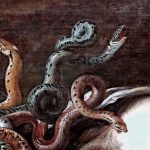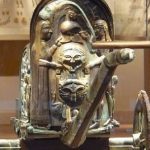 History
History  History
History  Movies and TV
Movies and TV 10 Practical Movie Monsters Remade with CGI
 Politics
Politics 10 U.S. Presidents Who Cheated on Their Wives
 Humans
Humans The 20th Century’s 10 Most Famous Centenarians
 History
History 10 Influencers Who Lived Centuries before Social Media
 Miscellaneous
Miscellaneous 10 Ancient Etiquette Rules You Never Knew Existed
 Our World
Our World Planet Earth’s 10 Most Hardcore Natural Creations
 Movies and TV
Movies and TV 10 Times Twin Movies Competed with Each Other
 The Arts
The Arts 10 Masterpieces Plucked from the Artist’s Subconscious
 Crime
Crime 10 Fascinating Facts about Rikers Island
 History
History 10 Shocking Roman Assassinations That Inspired the Ides of March
 Movies and TV
Movies and TV 10 Practical Movie Monsters Remade with CGI
 Politics
Politics 10 U.S. Presidents Who Cheated on Their Wives
Who's Behind Listverse?

Jamie Frater
Head Editor
Jamie founded Listverse due to an insatiable desire to share fascinating, obscure, and bizarre facts. He has been a guest speaker on numerous national radio and television stations and is a five time published author.
More About Us Humans
Humans The 20th Century’s 10 Most Famous Centenarians
 History
History 10 Influencers Who Lived Centuries before Social Media
 Miscellaneous
Miscellaneous 10 Ancient Etiquette Rules You Never Knew Existed
 Our World
Our World Planet Earth’s 10 Most Hardcore Natural Creations
 Movies and TV
Movies and TV 10 Times Twin Movies Competed with Each Other
 The Arts
The Arts 10 Masterpieces Plucked from the Artist’s Subconscious
 Crime
Crime 10 Fascinating Facts about Rikers Island
10 Unusual and Incredible Reinterpretations of Classic Artworks
One way student artists learn is by copying the works of old masters. This tests their eye for detail and their technical skills. However, these recreations are usually made with traditional materials such as pencils and paints, and most artists stop doing them after their school days because they want to create something new.
This leaves a gap in the market for artists with an odd but impressive niche—recreating old masterpieces using unusual materials. Here are ten incredible examples of such artists and their work.
Related: Top 10 One-Color Paintings Worth More Than Your House
10 Garip Ay
Garip Ay is a Turkish artist who made headlines in 2016 with his amazing but ephemeral recreation of the Van Gogh classic The Starry Night. Garip used paint to create the remarkable replica, so you might wonder what happened to it. It did not get splashed in soup by activists, catch fire, or suffer any such fate which can befall art on canvas.
That is because the unusual medium on which Garip meticulously makes his art is water. He uses an ancient technique called ebru, which involves painting on the surface of dark, thickened water. Garip creates his pieces with careful, satisfying swirls and splashes of paint. The finished products only exist for a moment before a final swirl washes them away forever.[1]
9 James Cook
While we need art historians to teach us about hidden messages in old masterpieces, eagle-eyed non-experts can find them in James Cook’s work. In 2022, this young British artist recreated seven classic artworks using a typewriter. Since he had to include letters in his pictures, he could not resist concealing a few news items among the thousands of characters.
His large replica of American Gothic contains a reference to Liz Truss’s resignation as British Prime Minister. Still, Cook claims you have to know where to look for it. He also recreated famous pieces like the Mona Lisa and Girl with a Pearl Earring. The artist says he was inspired by Paul Smith, an early typewriter artist, and the fact that typewriting technology still exists while technologies in our lives today—especially social media sites—seem to be in danger of disappearing.[2]
8 Ai Weiwei
Anyone who has visited a Legoland theme park is impressed with the array of sculptures on display, but those pale in comparison to Chinese artist Ai Weiwei’s enormous recreation of Monet’s Water Lillies #1. The 50-foot-long (15.2-meter) piece—and each of the 650,000 pieces of Lego he used—is part of a 2023 collection at the Design Museum in London.
This might sound like a big challenge to even the most avid Lego fan, but Ai Weiwei has had a lot of practice. In 2014, he produced 176 portraits of political prisoners using the colorful bricks. Experts say using Lego suggests the digitized age in which we live. But, in the past, Ai Weiwei has also used fences, rubber inflatables, and bicycles in his art. Weiwei included some personal features within the replica, such as a dark patch among the flowers representing the entrance to a dugout where his family lived.[3]
7 Jane Perkins
Jane Perkins also found that Monet’s Impressionist paintings lend themselves to her art. She says Impressionist works must be viewed from afar and up close. From a distance, people can make sense of the whole image, which is not obvious when the brush strokes are viewed up close. Perkins achieves the same effect by replacing brushstrokes with physical objects—her works resemble famous masterpieces from afar but are very different from up close.
Perkins limits herself to “found materials”—only using objects which are already the right size, shape, and color. They have to be used “as found” and cannot be changed. Her “Plastic Classics” collection features brightly colored recreations of Monet, Van Gogh, Klimt, Warhol, and more. Each piece was painstakingly constructed from toys, shells, buttons, beads, and even broken jewelry.[4]
6 Seikou Yamaoka
Fingerpainting is a popular activity for children, but it might take off among adults thanks to recent technologies and the art of Seikou Yamaoka, an office worker in Osaka, Japan. Yamaoka has shown that history’s greatest works of art can be accurately replicated using only a finger and an iPad—no cleanup required. The art graduate took an office job when he did not believe he could make a career out of art.
After a lengthy break, he returned to his passion by painting on his iPad. He began posting videos of his creations—which include popular classics like Girl with a Pearl Earring—on YouTube. In time, his channel became a hit and started receiving hundreds of thousands of views. Although he can work from anywhere, he has been known to work with his iPad taking the place of a canvas on an easel.[5]
5 Carl Warner
Are recreations of famous paintings really “art”? Each element of Ai Weiwei’s Water Lillies has an artistic reason, and Jane Perkins says re-interpreting others’ work has been used for centuries as a practice method, even by Picasso and Da Vinci. Nonetheless, replicas can be created for commercial reasons, like Carl Warner’s savory recreation of Da Vinci’s self-portrait.
To celebrate the 500th anniversary of the Italian artist’s death in 2019, Carl was commissioned by an Italian restaurant chain in the UK to reproduce the self-portrait using classic Italian ingredients. It took over 20 hours and—in a fitting tribute to the man who once designed a “spaghetti-making machine”—featured the stringy pasta as Da Vinci’s beard. That was one of six types of pasta, three cured meats, and two artisan breads used in the piece, along with mozzarella cheese and olives.[6]
4 Mil Cannon
Another delicious Da Vinci replica comes from Mil Cannon, a visual artist from Atlanta. Surprisingly, his 2015 interpretation of The Last Supper using French fries and ketchup was not made to promote a fast food chain but to highlight the problem of world hunger. After having worked with superstars like Usher and Whitney Houston, Cannon was commissioned by SERV International, a non-profit aiming to end world hunger.
The organization hoped Cannon’s work would help to highlight how much people spend on fast food and how many people they could help by donating a small part of that. Creating The Last Supper out of ketchup took three hours, two large orders of French fries, and twelve packets of ketchup. A video of the process was published on YouTube and ends with a reminder of the thousands of people who eat their own last supper each day.[7]
3 Justin Bateman
Justin Bateman is a British artist based in Chiang Mai, Thailand, and the beautiful beaches of his adopted home are both his materials and canvas. Bateman developed the peculiar specialty of impromptu pebble portraits. He uses the smooth stones to reproduce classic works of art such as Frida Kahlo’s self-portrait and Botticelli’s The Birth of Venus, in addition to portraits of famous figures including George Washington and Sir David Attenborough.
Because he uses only pebbles that he finds, the works cannot be planned in advance. Justin works wherever inspiration strikes—beaches, mountains, forests, and even by railway tracks. A piece can take several days to complete, after which Justin takes a photograph to remember it by. Following that, he is happy for nature to reclaim its materials.[8]
2 Lucy Sparrow
It takes silence to appreciate a work of art. While galleries are usually quiet places, they still suffer from echoes. Lucy Sparrow found a unique remedy to this problem which allowed visitors to China’s M Woods Museum to enjoy famous artworks in almost complete silence. Lucy recreated works from Rembrandt and Van Gogh to Edward Hopper and Damien Hirst out of felt. The British artist’s “Felt Art Imaginarium” took nine months to complete in 2019, with individual pieces taking around three days.
Sparrow covered 14 rooms across three stories with the soft fabric, including the walls. As an artist, Sparrow appreciates the versatility of felt, but as a human, she believes its tactile qualities promote happiness. She has used the material since childhood and previously created fully-stocked felt convenience stores in London and New York.[9]
1 Unknown Artist

The final example comes from a Russian commercial for Philips Electronics in 2012. These pieces are not impressive because of the level of detail they reproduce, but the amount they leave out while keeping the essence of the original. Anyone who has lifted an iron will appreciate the technical skill it must have taken to make them, as this artist was able to iron creases into white bedsheets to resemble works by Dutch masters.
The artist was able to shape the pearl-colored sheet into Vermeer’s famous Girl with a Pearl Earring, and he reproduced self-portraits of Rembrandt and Van Gogh. It is unknown whether the works were preserved. Still, the process exists on video as part of the consumer electronics brand’s promotional campaign.[10]








